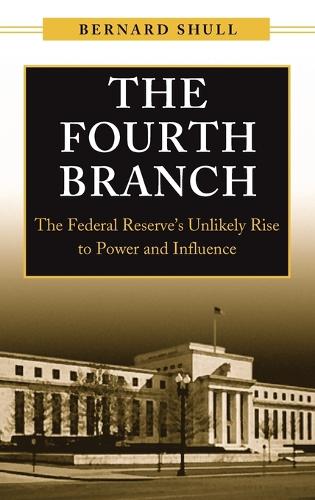
The Fourth Branch: The Federal Reserve's Unlikely Rise to Power and Influence
(Hardback)
Publishing Details
The Fourth Branch: The Federal Reserve's Unlikely Rise to Power and Influence
By (Author) Bernard Shull
Bloomsbury Publishing PLC
Praeger Publishers Inc
30th July 2005
United States
Classifications
Professional and Scholarly
Non Fiction
332.110973
Physical Properties
Hardback
272
Description
Shrouded in mystery, managed behind closed doors, and the subject of both awe and derision, the Federal Reserve is commonly referred to as the fourth branch of our federal government, with wide-ranging influence over monetary policy, and by extension, banking, price levels, employment rates, and economic growth, income, and wealth. Bernard Shull traces the fascinating and improbable history of this institution from its establishment by an Act of Congress in 1913 to the present day. His careful analysis reveals a paradoxical phenomenon: focusing on three periods of economic stress (the inflation and deflation following World War I, the stock market crash of 1929 and subsequent Depression, and the stagflation and volatility of the 1970s and 1980s), Shull argues that despite convincing evidence that the Fed contributed to these crises, it has consistently emerged from each more powerful and influential than before. Setting the current profile of the Fed against its evolutionary context, The Fourth Branch sheds new light on the Fed's character and its impact on our economic, political, and cultural history. In many ways, the story of the Fed is the classic American epic: turning adversity into opportunity, responding to threat by innovating and adapting. Even today, under attack by liberals and conservatives alikein the wake of the stock market bubble, economic recession, and rampant job lossthe Fed is poised to remain strong long after the tenure of legendary Chairman Alan Greenspan. Setting the current profile of the Fed against its evolutionary context, The Fourth Branch sheds new light on the Fed's character and its impact on our economic, political, and cultural history.
Reviews
Shull provides a good overview of the history of the Federal Reserve, emphasizing its role in three economic crises: the inflation and sudden deflation of 1919-21, the Great Depression, and the stagflation period of 1973-82. In each of these events, the Federal Reserve played an undistinguished role, and was often fingered as a major cause of the problem. Despite its failures, in the wake of each crisis the Federal Reserve emerged with enhanced powers. The author credits the success of the Federal Reserve in expanding its power to its willingness to change course when conditions require it. One could just as well conclude from the evidence presented in this work that the Federal Reserve has been rewarded because it has proven itself willing and able to serve the financial community. Shull, whose career includes working for the board of governors of the Federal Reserve and the Office of the Comptroller of the Currency as well as teaching, brings both archival material and the established literature into play. His book is well written and for the most part avoids technical analysis, making it accessible to undergraduate students. Recommended. Public and academic library collections, lower-division undergraduate and up. * Choice *
Dr. Shull examines how, despite convincing evidence that misguided Federal Reserve policy exacerbated a number of major economic crises, the institution has consistently emerged from each crisis more powerful and influential than before. By focusing on three critical periods of economic stress (the inflation and deflation following World War I, the stock market crash of 1929 and subsequent Depression, and the volatility of the 1970s and 1980s), Dr. Shull argues that the key to the Federal Reserve's unexpected success has been awareness of its immense value in national emergencies and its capacity to adapt to the changing economic conditions and political realities of the past century. * NERA.COM *
Author Bio
Bernard Shull is Professor Emeritus in the Department of Economics, Hunter College, and a special consultant for National Economic Research Associates (NERA). He has held various positions in the Federal Reserve System, including Associate Advisor to the Board of Governors. He was also Senior Economist in the Office of the Comptroller of the Currency. He has published widely in professional and academic journals on issues of monetary, banking, and financial policy, and is the co-author of two books, Interest Rate Volatility and Bank Mergers in a Deregulated Environment (Quorum, 2001).
